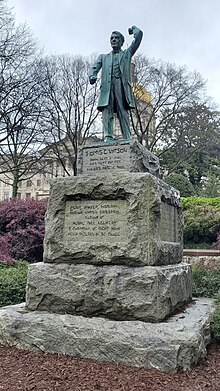
Thomas Edward Watson was an American Populist and white supremacist politician, attorney, newspaper editor, and writer from Georgia. In the 1890s Watson championed poor farmers as a leader of the Populist Party, articulating an agrarian political viewpoint while attacking business, bankers, railroads, Democratic President Grover Cleveland, and the Democratic Party. He was the nominee for vice president with Democrat William Jennings Bryan in 1896 on the Populist ticket.
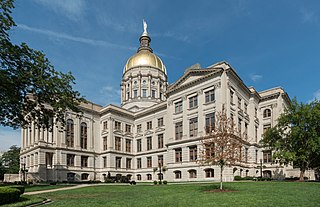
The Georgia State Capitol is an architecturally and historically significant building in Atlanta, Georgia, United States. The building has been named a National Historic Landmark which is listed on the National Register of Historic Places. As the primary office building of Georgia's government, the capitol houses the offices of the governor, lieutenant governor, and secretary of state on the second floor, chambers in which the General Assembly, consisting of the Georgia State Senate and Georgia House of Representatives, meets annually from January to April. The fourth floor houses visitors' galleries overlooking the legislative chambers and a museum located near the rotunda in which a statue of Miss Freedom caps the dome.
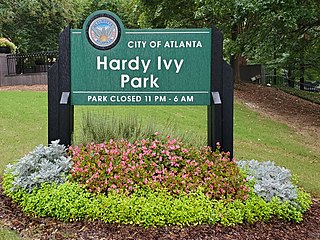
Hardy Ivy Park is a pocket park in downtown Atlanta, Georgia, United States.

The Erskine Memorial Fountain is a public fountain in Grant Park of Atlanta, Georgia, United States. Designed by J. Massey Rhind in honor of John Erskine, it was the first public fountain in Atlanta. The fountain was built in 1896 and moved to its current location in 1912.
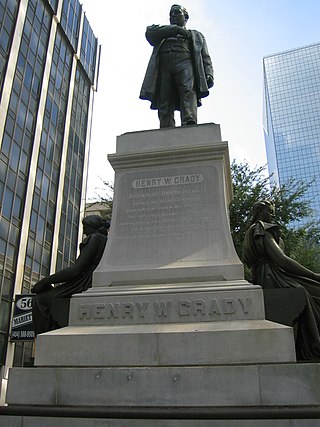
The Henry W. Grady statue is a monumental statue of Henry W. Grady in Atlanta, Georgia, United States. Built by Alexander Doyle in 1891, the statue lies at the intersection of Marietta Street and Forsyth Street in downtown Atlanta and was unveiled shortly after Grady's death in 1889. The statue has recently been the subject of controversy, as several groups have called for its removal due to Grady's support of white supremacy.

The DeKalb County Confederate Monument is a Confederate memorial that formerly stood in Decatur, Georgia, United States. The 30-foot stone obelisk was erected by the United Daughters of the Confederacy near the old county courthouse in 1908.
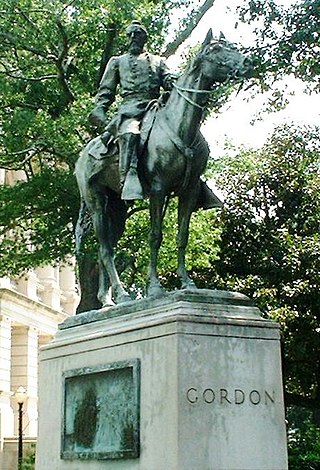
The equestrian statue of John Brown Gordon is a monument on the grounds of the Georgia State Capitol in Atlanta, Georgia, United States. The monument, an equestrian statue, honors John Brown Gordon, a general in the Confederate States Army during the American Civil War who later become a politician in post-Reconstruction era Georgia. Designed by Solon Borglum, the statue was dedicated in 1907 to large fanfare. The statue has recently become a figure of controversy over Gordon's racist views and associations with the Confederacy, with some calling for its removal.

The Martin Luther King Jr. statue is a public monument of civil rights activist Martin Luther King Jr. in Atlanta, Georgia. The statue, designed by Martin Dawe, was unveiled in 2017 and stands on the grounds of the Georgia State Capitol, overlooking Liberty Plaza.
The Thomas Jefferson statue is a bronze statue of Thomas Jefferson which was formerly located on a bench next to the Old DeKalb County Courthouse in Decatur, Georgia. The statue depicts Jefferson writing the United States Declaration of Independence and was donated to the city by a private citizen to honor U.S. senator Paul Coverdell, who died in 2000. Following a rally during the George Floyd protests on June 17, 2020, it was announced that the statue would be removed, citing the fact that Jefferson was a slave-owner who owned over 600 slaves and fathered several children with Sally Hemings, his sister-in-law and a slave he owned. On the morning of June 19, 2020 the statue was removed at the request of the donor "to protect it from damage." This came several days after the removal of the DeKalb County Confederate Monument, an obelisk on the courthouse grounds that honored the Lost Cause of the Confederacy.
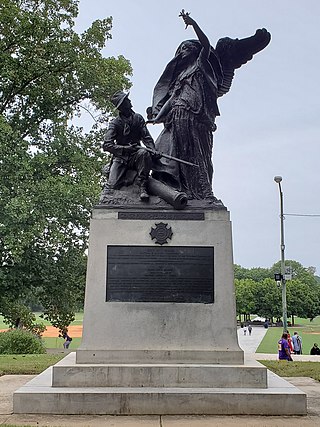
The Peace Monument is a public monument in Atlanta, Georgia, United States. Designed by Allen George Newman, the monument is located in Piedmont Park and was erected in 1911 by members of the Old Guard of the Gate City Guard, a Confederate-era militia, as a show of national unity in the years following the American Civil War. The monument has been the subject of controversy recently, with some calling for its removal as a symbol of the Lost Cause of the Confederacy.

The Eugene Talmadge statue is a public monument located on the grounds of the Georgia State Capitol in Atlanta, Georgia. Designed by Steffen Thomas, the statue was unveiled in 1949 and depicts Georgia Governor Eugene Talmadge. The statue has been the subject of recent controversy given Talmadge's white supremacist and racist views.

The Confederate Obelisk is a large Confederate monument located in the Oakland Cemetery of Atlanta, Georgia, United States. The structure, a tall obelisk located in the cemetery's Confederate section, was dedicated in 1874. Due to its connection to the Confederate States of America, the monument has been vandalized repeatedly.

The Sidney Lanier Monument is a public monument in Atlanta, Georgia, United States. Located in Piedmont Park, the monument consists of a bust of Sidney Lanier, a notable poet from Georgia. The monument was dedicated in 1914.
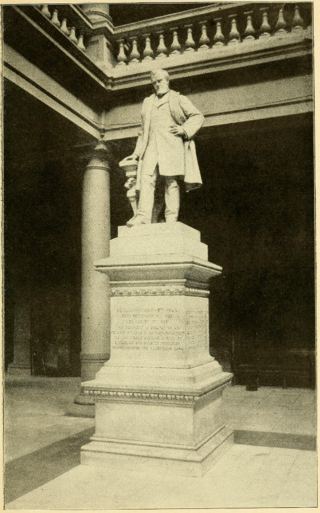
A statue of Benjamin Harvey Hill stands inside the Georgia State Capitol in Atlanta, Georgia, United States. The monumental statue was designed by American sculptor Alexander Doyle and originally dedicated in 1886 at what is now Hardy Ivy Park. The statue was relocated to the capitol building in 1890.

Hope Moving Forward is a public monument in Atlanta, Georgia, United States. Dedicated in 2021, the monument consists of a bronze statue of Martin Luther King Jr. designed by Basil Watson atop a pedestal. It is located at the intersection of Northside Drive and Martin Luther King Jr. Drive.

The George Floyd protests in Atlanta were a series of protests occurring in Atlanta, the capital and largest city of Georgia, United States. The protests were part of the George Floyd protests and, more broadly, the 2020–2021 United States racial unrest, which began shortly after the murder of George Floyd by police officer Derek Chauvin in Minneapolis on May 25, 2020. On May 26, protesting occurred in the Minneapolis–Saint Paul area and, over the next several weeks, protests spread to cities throughout the United States and then internationally.
